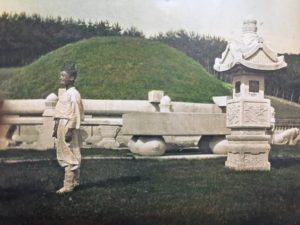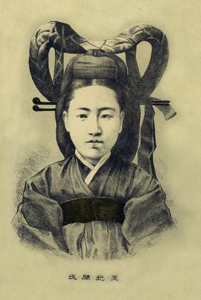Thursday, 8 November 2018
The plan was to visit the Tomb of Queen Min. The Gambles had been there and the photograph taken by Clarence and Sidney is a good one.
Donggureung, East Nine Royal Tombs, is a cluster of tombs of the rulers of the Joseon Dynasty on a site just outside of Seoul. Clarence writes that at Donggureung. along with the tomb of Queen Min (pictured above), they saw the apartments of the king and an audience hall for the queen’s spirit. I wanted to see all this for myself and verify what Clarence had written.
I was given specific directions Take Bus 272 and after twenty stops, transfer to Bus 202 and after sixteen stops on Bus 202, I will have arrived at Donggureung, the burial grounds of the Joseon Dynasty. Alas! Alighting from Bus 272 at the twentieth stop, I found no stop for Bus 202. It was a long and disappointing bus ride. Later, another authority said I should have gotten off at the nineteenth shop. Well, the day was spent on twenty bus stops and now too late in the day to start over. It was also raining hard, bitterly cold, windy, and my long pants were soaking wet. So perhaps try again tomorrow.
In the meantime, the Empress Myeong-dong, or Myung Sung, known informally as Queen Min, deserves to be honored for herself, not just because I want to verify the photo taken by Clarence and Sidney. She was a powerful woman. At barely sixteen years of age, she was married to the fifteen-year-old King Gojong, the twenty-sixth king of the Joseon Dynasty. She was slight and beautiful, of aristocratic lineage, and considered the perfect bride for the king. It was assumed she would be a subservient, pliable wife and play the role of dutiful hostess at royal functions.
But once married and settled into the palace, she did not follow the customary ways of earlier queens. She refused to go to royal parties, but preferred to read books in her room. She did not order expensive clothes of the latest fashion. She would not hold tea parties for the other ladies of the court. At the age of twenty, she began to investigate the activities of the ministers, the workings of the court and those of the government itself. And then she began to make suggestions. She was soon accused of meddling. Eventually, she formed a powerful political faction that supported her, while intrigues multiplied and surrounded her every move. During this same period, Japan was steadily moving forward with its planned takeover of Korea, a plan also supported by some Koreans for their own purposes,
Queen Min was aware of the intentions of Japan as well as of the forces and collaborators who supported Japan, and she sought through political and diplomatic steps to secure ties with the West and with Russia, giving her means to counter the pro-Japanese forces. Her growing popularity and increasing political strength occasioned great concern by the Japanese, who arranged to have her assassinated by Japanese ronin hired specifically for the job. On 8 October 1895, with the aid of two Korean battalion guard collaborators, the palace guards at Gyeongbokgung were attacked and dispatched, leaving the queen completely unprotected. She was stabbed, probably repeatedly, brutally murdered, and her body burned on the spot. Without her leadership, resistance to the Japanese was weakened, and, as we know, Japan ultimately was able to annex Korea as a protectorate, that status continuing until the end of World War II.
Here is a picture of Queen Min And here is a photo taken at Donggureung, one way to sew the burial sights without traveling through thirty-six bus stops Or would it be thirty-five?




